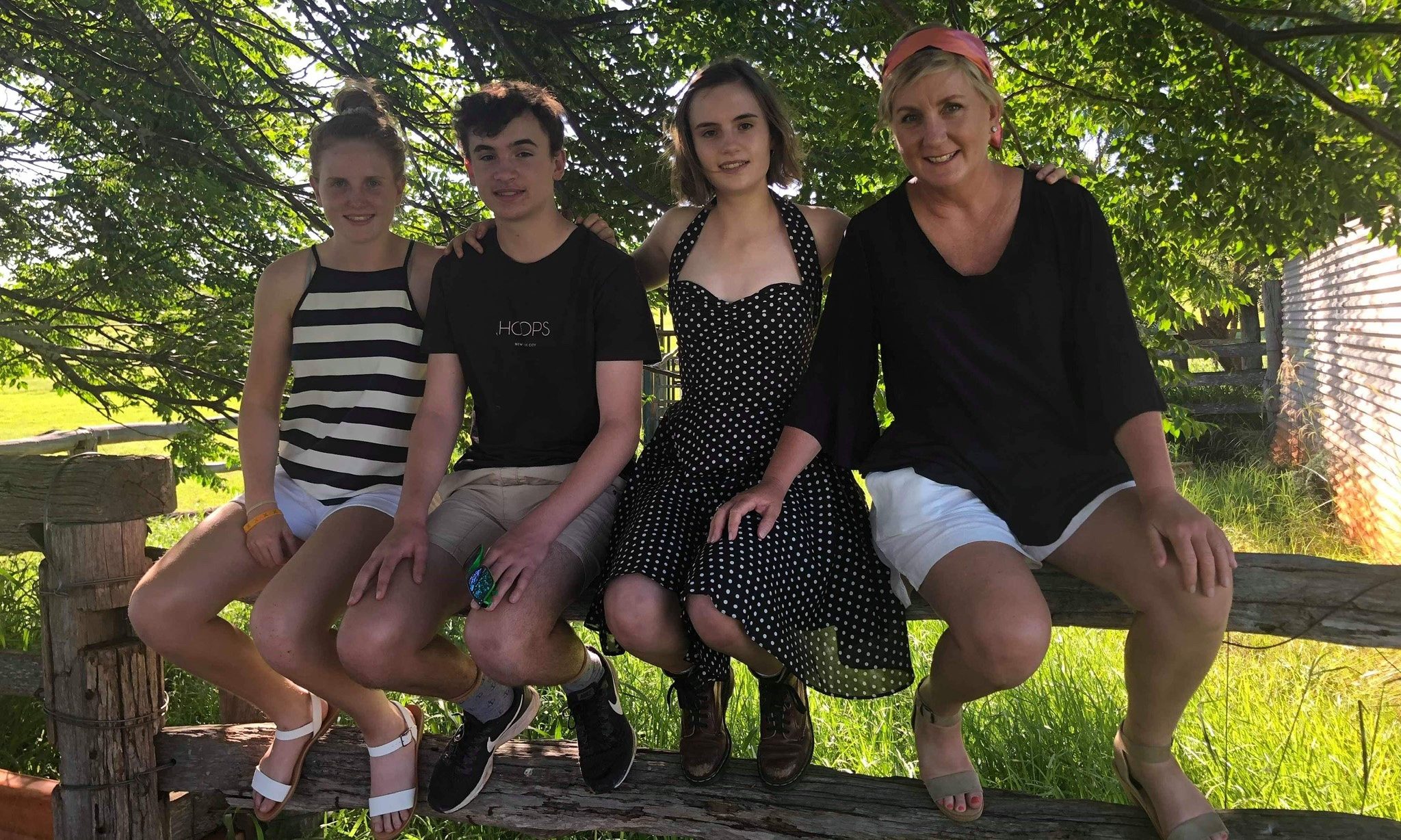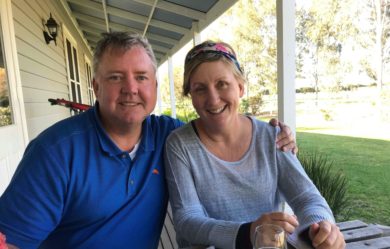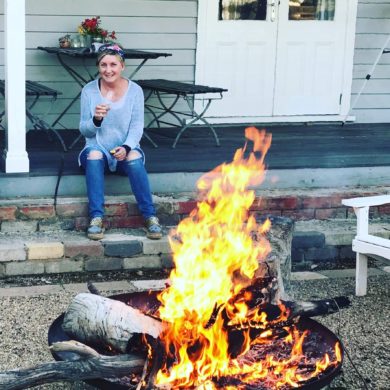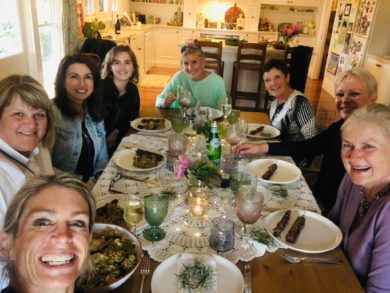Bronwyn advocated for when and where she was treated

By the time Bronwyn Bisley was finally given a diagnosis, via Skype in April 2018, she already knew she had Hodgkin lymphoma (HL) – she’d worked that out for herself!
‘I’d done enough online research, exactly what you’re not supposed to do. I thought it couldn’t be anything else, I’d looked up the symptoms. I knew it was Hodgkin’s,” said Bronwyn about her complex and “very long journey” to diagnosis.
Bronwyn’s life was busy, as a single mum, raising three children, then aged 13-16, and a teacher working full-time “for financial reasons”. For eight years, they’d all lived on a “big horse property” at Tatura, a 25-minute drive from Shepparton (Vic), which she looked after for friends, and it took a lot of effort “to keep beautiful and nice”.
Her eldest child had been three when Bronwyn and her husband separated.
“One of my children is deaf/blind, so I had that experience to go through and upskill, another was really ill for a year and that a took a lot of energy, and my ex decided to take me through family court for five years which was tough as I couldn’t afford legal support,” said Bronwyn.

Her long journey to being diagnosed
“As a teacher, we always say – ‘you get to the holidays and you get sick’.
“I was getting to the end of what I could manage personally, and I got sick,” said Bronwyn about the Christmas holidays of 2017.
“I was working hard on the farm and in the garden and noticed if I had a glass of wine, I had lots of symptoms. I was feeling okay, but pretty flat. I was bloated in the face and could feel a swelling in my neck when I swallowed.
“I decided to go to the doctor but couldn’t get in for three weeks and by that stage I was back at work.
“The doctor couldn’t feel anything but sent me off for a CT scan which was a big deal because they are expensive.
“They found some hot spots, mainly in my breasts, and were positive it was breast cancer, but no diagnosis.
“I was sent to an oncologist, which was all very scary, but I thought it would be nice to know.
“It went on and on… lots of appointments, CT scans, biopsies, this and that, surgery on my breast to remove two lumps and still nothing. Eventually the oncologist said, ‘no I don’t think it’s breast cancer – it’s something else’.
“A haematologist contacted me in April and said, ‘there’s been lots of stuffing around, could you come to Melbourne and we’ll do a proper biopsy?’.
“I said sure, that will be great, let’s get to the bottom of this, and finally a diagnosis arrived via Skype at the end of April 2018,” said Bronwyn, who was 48 at the time.
“She [the haematologist] basically just said ‘you won’t take in too much now, this is all a bit overwhelming, do you have any questions?’.
“I didn’t really know what to ask,” said Bronwyn, who was told she would have six months of chemotherapy with four drugs* at Shepparton.
“Then I didn’t see her again for a really long time.”

Bronwyn’s treatment experiences and decisions
First, she had to wait before starting treatment until she healed from having surgery to remove the lumps and “a fair chunk of one breast”. They weren’t cancerous.
“I was a bit worried about the chemotherapy,” said Bronwyn, her concern being the late-effects of having the treatment on her future quality of life.
“And being off work for six months absolutely floored me. I couldn’t think of anything else apart from how the hell I was going to manage that and pay to live.
“I told the kids ‘it’s Hodgkin’s… no problem, we’ll knock this over’. They weren’t that alarmed and seemed to cope pretty well. Nothing much changed for them. My strategy was – they’re not at fault here, so how can we keep their lives mainstream”
All Bronwyn’s family live in Queensland, but her brother and sister were both able to tag team, staying on and off with Bronwyn at Tatura over the next six months.
But Bronwyn didn’t cope well with the fortnightly regimen* of chemo at the oncology centre at Shepparton, and after the first few months she decided to stop treatment.
“I was really, really ill and couldn’t stop vomiting,” she said.
“No-one was managing my symptoms and having the four drugs was taking up to four hours. With lots of sitting around waiting for the next drug, I was getting really distressed.
“And I couldn’t contact my doctor and hadn’t seen her for a few months.
“The nurses were fantastic, but they were constantly understaffed. Every time I went in, it just took longer and longer, until the last time, when I said – ‘look, I’m not coming back’.
“I didn’t want to be on that factory line for six months, having no discussions with my haematologist, and with me being that sick and getting worse.”
When her first PET scan “was pretty clear”, she decided to seek other advice.

Taking control of the ‘what, where and when’ of her treatment
“I gave myself a few weeks off, to get more information. I spoke to some alternative therapy experts and friends helped me find a haematologist in Melbourne who wouldn’t treat me like a number, and I was happy to go private if I had to.”
After getting the same recommendation from four different people, Bronwyn made an appointment with another haematologist and went down to Melbourne to weigh up her options.
“She gave me the time of day – an hour and a half discussion – and understood straight away, saying ‘no one needs to be vomiting, we can stop that immediately’.
“So I went back to chemo, for a few rounds, and could do really low-dose radiation as well, which I elected to do, combined with some pretty severe lifestyle changes.
“I never vomited again and never had the horrendous symptoms, so the whole thing was very different.
“I had one person assigned to me and everything was really quick. The first time was so fast, I was like – oh, did I get all four [drugs]?
“Then I was waiting to feel sick and the anti-nausea medication actually worked!
“Everything just became a lot better, not so much that I wanted to keep going on chemo! But it was much more manageable, and I felt like if I had a problem, there was someone there to solve it immediately.”
And, based on all the research she’d done and the journal articles she’d read, Bronwyn decided to have supplements and natural therapies as well, when she wasn’t actually having the conventional treatment.
“Nothing super weird, just really good nutrition,” she said.
“And I exercised all through chemo. I walked every day. I’d read that is really valuable, particularly straight after treatment.”
“My family was pretty worried at my decision, so we had lots of discussions,” said Bronwyn, who only found out later that she had limited information about her diagnosis; she actually had three hot spots and her HL was stage IIB.
Support from the Leukaemia Foundation
Bronwyn said she “wouldn’t have managed at all” if she hadn’t had support from the Leukaemia Foundation.
“Having someone [a blood cancer support coordinator] who checked in and said, ‘is there anything we can help you with?’ kept me going,” said Bronwyn.
“And I felt comfortable to ring and say, ‘I’m confused about this, or I’m struggling financially, or I’m wondering how to get to my appointments, or I can’t afford a big flash wig – are there any other options?’.
“I needed to find accommodation for the six weeks of radiation treatment in Melbourne and the Leukaemia Foundation was instrumental in that,” said Bronwyn.
She also had “the most wonderful experience with the drivers” – the transport team of volunteers who drove her to Melbourne and back home to Tatura.
“I can’t tell you how much I looked forward to those trips. Often, I was on my own with the driver and we would just talk flat out for 1½ to 2 hours.
“I really valued that. It made me feel like a human,” said Bronwyn, and it felt special to have this connection with someone she didn’t know.
“To me they were life-changing events.
“When you’re going through a time like that, you’re so sick, you don’t go out into the community. For five months, my neutrophils were always zero, so I was isolated, and these car trips were special times.”
Getting on with life after treatment
At the end of November 2018, Bronwyn finished treatment and after giving herself a little bit of time, she went back to work on December 20, “wearing a wig”.
“We moved house this year, which is absolutely amazing. We’re in town now, so less housework, no farm work, less garden, nothing huge to grapple with.
“My aim this year was to focus on being present and to live within the reality of what we have and who we are and making the most of that,” said Bronwyn, now 50.
At the end of September, she celebrated her 50th with a three-day bike ride with a group of girlfriends, from Beechworth to Bright through the wineries.
How lymphoma has changed Bronwyn
“You do take a bit of a glance back and see the reality of your life.
“You only get one bash at this. I’m being more mindful of that and enjoying the present because you become more in touch with… this is it, this is who I am, this is where I’m at …and that’s okay, so just embrace it.
“I think it strengthened me in terms of working with that and making the best of it.”
Bronwyn’s advice
“Everyone is on their own path and everyone deals with these things so differently. Just listen and understand that it’s going to be your own journey and it will be very different to anybody else’s.”
*The ABVD chemotherapy protocol: doxorubicin, bleomycin, vinblastine, dacarbazine.
Last updated on August 6th, 2020
Developed by the Leukaemia Foundation in consultation with people living with a blood cancer, Leukaemia Foundation support staff, haematology nursing staff and/or Australian clinical haematologists. This content is provided for information purposes only and we urge you to always seek advice from a registered health care professional for diagnosis, treatment and answers to your medical questions, including the suitability of a particular therapy, service, product or treatment in your circumstances. The Leukaemia Foundation shall not bear any liability for any person relying on the materials contained on this website.